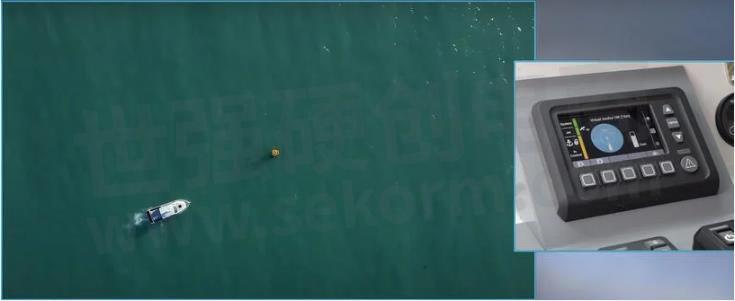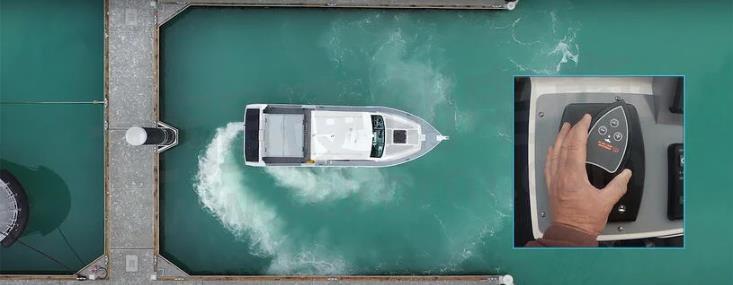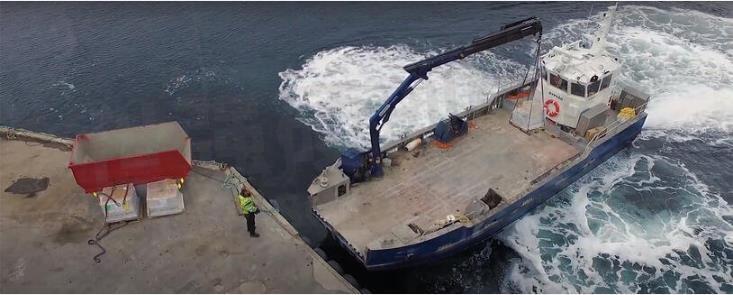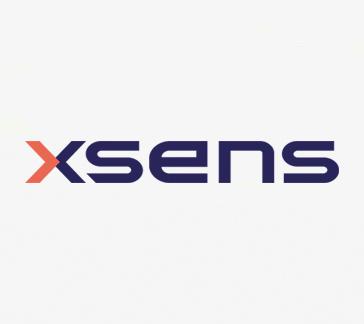Advanced HamiltonJet Propulsion Control System Uses MTi Motion Tracker to Keep A Boat Still on Moving Water




In the late 1950s, New Zealand marine technology company HamiltonJet pioneered the application of waterjet propulsion for small and medium-sized craft. Waterjet propulsion was the ideal alternative to a conventional propeller drive for boats operating in shallow water, and quickly found favor among skippers of boats plying New Zealand's many shallow, rocky rivers.
Since then, HamiltonJet has grown to become the world's biggest supplier of waterjet propulsion and control systems, with over 40% market share worldwide – some 97% of its sales are to export markets. Its sophisticated AVX platform provides the basis for a growing range of skipper assistance and auto-pilot functions, all of which depend on accurate and robust technology for tracking a vessel's position and its movement in the water.
A crucial role in this platform is played by an MTi-2 motion tracker from XSENS, providing real-time measurements of roll and pitch to enable the HamiltonJet system to fix the position of a vessel on the water. This is the story of the HamiltonJet technology, and the MTi motion tracker's role in it.
Innovative propulsion system enables accurate station keeping
Today, waterjets propel a wide range of service boats which require very high maneuverability, benefit from high efficiency at high speed, or operate in shallow waters. Typical users of HamiltonJet propulsion systems include police patrol boats, service vessels supporting wind farms, rescue and fire service boats, recreational and tourist boats, and military vessels.
One of the most apparent differences between a waterjet propulsion system and propeller systems is the quick and easy control of the direction and power of the thrust. A HamiltonJet propulsion system can completely reverse the direction of thrust in less than two seconds.
This property of waterjet propulsion enabled HamiltonJet to develop a sophisticated system for automatically performing 'station keeping' – the mariner's term for staying motionless on the surface of the water while maintaining a constant heading.
Its JETanchor product for station keeping, or providing a 'virtual anchor', is an optional feature of the AVX propulsion control system. Playing a vital role in the JETanchor's position sensing system is an MTi-2 Vertical Reference Unit (VRU) from Xsens.

Compensation for satellite positioning signal error
The JETanchor product enables the skipper to hold the vessel steady at the push of a button. The system has to know the absolute position of the vessel. Of course, technology for monitoring the position of an object is readily available: Global Navigation Satellite System (GNSS) positioning signals are capable of high accuracy and precision.
The JETanchor system uses dual satellite receivers. Each is mounted on a mast to maintain a clear line of sight to the Global Positioning System (GPS) constellation. The satellite receivers provide position data accurate to a few tens of centimeters, as well as reliable measurements of heading and, when the vessel is in motion, velocity.

As accurate as the dual GPS signals are, however, they are not sufficient for the JETanchor system to meet the high performance standards that HamiltonJet sets for its propulsion control products, chiefly because of the nature of operation on water. At sea, boats are rocked almost constantly by the motion of the wind and waves. An unmoored boat is never completely still.
The effect of roll and pitch is amplified by the GPS receivers' mounted position high up on masts. In heavy seas, the action of roll and pitch can cause receivers mounted on tall masts to detect movement of several meters from one side of the mast's arc of motion to the other, while the dead center of the hull remains motionless.
In other words, this swinging of the mast introduces error into the GPS signal. The role of the MTi-2 VRU is to measure the hull's roll and pitch. Once the mounting positions of the GPS receivers and of the VRU are programmed into the AVX control system, sophisticated JETanchor algorithms apply calculations in real time to cancel out the error in the GPS signals induced by movement of the water, resulting in a clean position signal. This then enables the waterjet propulsion system to minutely adjust the position of the hull on the water at a rate of ten times per second.

According to CJ Johansson, Senior Systems Engineer at HamiltonJet, a crucial feature of the Xsens VRU is its measurement stability even when subject to vibration – an ever-present phenomenon affecting the operation of motion trackers mounted on a vessel. He says, 'Xsens implements very effective Kalman filtering technology in its sensor modules which automatically cancels out the effect of random vibrations induced by phenomena such as the impact of waves on the hull, or the operation of the boat's engine. This vibration filtering means that we can use the roll and pitch signal outputs from the MTi-2 motion tracker with great confidence. It also leaves the main AVX control system free to implement its principal control functions, without having to perform error compensation of the roll/pitch signal.'
The accuracy and stability of the MTi-2 VRU play a crucial role in enabling the JETanchor product to achieve high performance. It can typically maintain a vessel's position to within 1m at sea. System tests have demonstrated the system's ability to maintain a cargo vessel's station 1m from a wharf while a 1 tonne load of bricks was lifted by crane to shore.

Ben Reed, CEO of HamiltonJet, says: 'Our goal in developing the JETanchor product was to bring station keeping to mainstream vessels. In large commercial vessels and ferries, station keeping is a feature which can cost as much as $0.5m to install. JETanchor is typically priced at less than 10% of this, yet its performance in a waterjet propulsion system rivals that of much more expensive systems. JETanchor's outstanding performance is a tribute to the skill and ingenuity of our engineering team, and to the quality of the technology inside it – including the affordable yet high-performance MTi motion tracker supplied by Xsens.’
- |
- +1 赞 0
- 收藏
- 评论 0
本文由翊翊所思转载自Xsens,原文标题为:Keeping A Boat Still On Moving Water: Advanced HamiltonJet Propulsion Control System Uses MTi Sensor For Roll And Pitch Compensation,本站所有转载文章系出于传递更多信息之目的,且明确注明来源,不希望被转载的媒体或个人可与我们联系,我们将立即进行删除处理。
相关推荐
【应用】Xsens推出包含MTi系列惯性传感器的AMR和AGV解决方案,为移动机器人提供高精度导航数据
Xsens MTi系列惯性传感器凭着其工业级精度、抗磁干扰能力强、高性价比等特点,与众多厂商在自动驾驶、机器人、无人机等领域有着深度的合作,帮助其产品打造出优异的导航效果。
Robotics Specialist Innok Robotics Uses MTi-30 motion tracker from Xsens In its AGVs For Outdoor Space
It is generally easier to design automated ground vehicles (AGVs) for indoor than for outdoor use. The solution Innok Robotics using for tracking the position of its AGVs with centimeter-level precision is a form of dead reckoning using the inputs from a sophisticated MTi-30 motion tracker from Xsens. And MTi-30‘s IP65 rating means that it is suitable for use outdoors.
【应用】Xsens的MTi-2运动跟踪器助力船舶喷水推进技术,提供了侧倾和俯仰的实时测量
HamiltonJet公司先进的AVX平台为船长辅助和自动驾驶提供了功能扩展的基础,而所有这些功能都依赖于精确而强大的技术来跟踪船只的位置及其在水中的运动。Xsens的MTi-2运动跟踪器在该平台中起着至关重要的作用,该跟踪器提供了侧倾和俯仰的实时测量,以使HamiltonJet系统能够将船只的位置固定在水上。本文就是关于HamiltonJet技术,以及MTi运动跟踪器如何在其中发挥作用的故事。
Xsens IMU惯性测量传感器选型指南
目录- IMU
型号- MTI-1,MTI-2,MTI-600,MTI-300,MTI-7,MTI-100,MTI-200,MTI-G-710,MTI-3,MTI-680,MTI-670,MTI-610,MTI-620,MTI-630
XSENS MTi系列MEMS惯性传感器选型指南
型号- MTI 100-系列,MTI 1-系列,MTI-G-710,MTI 1系列,MTI 600系列,MTI 600,MTI-670,MTI 1,MTI-610,MTI-630,MTI 100,MTI-1,MTI-680G,MTI,MTI-2,MTI-670G,MTI-7,MTI系列,MTI-3,MTI 600-系列,MTI-680,MTI-200,MTI-100,MTI 100系列,MTI-620,MTI-300
XSENS Motion Tracker Helps Innok Robotics Pioneers Sensor Fusion Agv Location In Complex Outdoor Terrains
It is generally easier to design automated ground vehicles (AGVs) for indoor than for outdoor use. Inside a warehouse, for instance, an AGV moves on a smoothly finished, flat surface, in an area enclosed by walls, and along fixed, dedicated routes which are marked with barriers or guidelines for navigation, and which eliminate the risk of collision with people or other objects.
Xsens MTi系列MTi系列参考手册的一般信息
描述- 本资料为Xsens MTi系列产品的参考手册,主要介绍了MTi系列产品的硬件平台、系统概述、安装技巧、保修和责任等内容。手册详细阐述了MTi系列产品的功能、特点、使用方法以及与Xsens软件套件(MTSS)的配合使用。此外,还提供了MTi产品的技术参数、数据输出协议、接口选项等信息。
型号- MTI 600-SERIES,MTI SERIES,MTI-G-710,MTI-670,MTI-610,MTI-630,MTI 10-SERIES,MTI-30,MTI-10,MTI-680G,MTI-1,MTI,MTI-2,MTI-7,MTI 1-SERIES,MTI 100-SERIES,MTI-3,MTX,MTW,MTI-200,MTI-100,MTI-G,MTI-620,MTI-300,MTI-20
【产品】基于MEMS的惯性IMU单元MTi 10系列,可提供IMU,VRU和AHRS三种集成度的产品
Xsens推出的MTi 10系列是基于MEMS的惯性IMU单元,能够提供可靠及灵活的解决方案。借助AHRS,VRU和IMU,该系列产品为系统集成商提供了三种不同的集成级别。该模块基于行业认可的,具有成本效益的,基于MEMS的方向传感器,并具有集成的、功能齐全的传感器融合算法和易于使用的SDK。
XSENS的IMU惯性测量单元具有完整传感器融合算法、精度高,一流硬件设计,支持多种集成等级 |视频
3D运动追踪技术和产品的主要创新者XSENS的IMU惯性测量单元:完整传感器融合算法;精度高;一流硬件设计,支持多种集成等级。在AGV、自动驾驶、卫星天线、安防、航天航空等多个领域中广泛应用。
【产品】具有板载XKF3™传感器融合算法的工业级惯性传感器模块MTi 1系列
Xsens推出的MTi 1系列具有板载XKF3™传感器融合算法的工业级惯性传感器模块,可限制应用处理器的负载。 它结合了最新的惯性微型MEMS技术,同时保持了相同的硬件和软件接口。 如果某个组件不再可用,则无需进行昂贵的开发。
ISM简介
型号- 1-SERIES,100-SERIES,MTI-6#0,MTI-#00,MTI-G-710,MTI-#0,MTI-670,MTI-610,MTI-630,MTI-#,MTI-30,MTI-1,MTI-680G,MTI-2,MTI-SERIES,MTI-630-DK,MTI-SERIES™,MTI-3-DK,MTI-7,10-SERIES,MTI-680R,600-SERIES,MTI-3,MTI-7-DK,MTI-#00-DK,MTI-680,MTI-670-DK,MTI-200,MTI-100,MTI-620,MTI-300,MTI SERIES™
【产品】最小的独立VRUMTi-2易于集成,可根据要求提供3D模型
MTi-2是市面上最小的独立VRU,由Xsens优化的捷联算法(AttitudeEngine™) 以1kHz的频率进行高速航位推测计算来精确捕捉高频运动,Xsens业界领先的传感器融合算法能在这个高性价比的模块中为多种(嵌入式)应用提供高精度和传感器自动校准。该产品减轻了设计、集成和维护陀螺仪、加速计和其他传感器的工作。
所有MT设备的MT Manager用户手册
描述- 本手册为Xsens MT Manager用户指南,适用于所有MT设备。内容涵盖MT Manager的安装、配置、基本功能、操作指南、系统要求等。MT Manager是一款易于使用的软件,具有Windows用户界面,可实时查看3D方向、惯性传感器和磁力传感器数据,实时查看纬度、经度、高度,通过消息终端与设备进行通信,导出日志文件到其他格式,更改和查看各种设备设置和属性,运行自检以检查惯性传感器和磁力计的机械功能。支持多种MT设备,包括MTi 1系列、MTi 10/100系列、MTi 600系列等。
型号- MTI 600-SERIES,MTI-680G,MTI,MTI-7,MTI-G-710,MTI 1-SERIES,MTI 100-SERIES,MTX,MTW,MTI-670,MTI-G,MTI-300,MTI-20,MTI-30,MTI 10-SERIES
Xsens MTI 1系列V2 EOL–产品停产通知
描述- Movella Technologies B.V.发布Xsens MTi 1-series v2产品系列的生命周期结束(EOL)通知。由于关键组件不可用,该产品系列将于2022年4月停止销售,并将于2022年12月31日停止技术支持。替代产品为Xsens MTi 1-series v3,客户需更新采购系统以使用新零件编号。
型号- MTI-1,MTI-2,MTI-7-DK,MTI-3-DK,MTI-1-0I,MTI-7,MTI 1-SERIES,MTI-3,MTI-7-0I,MTI-2-0I,MTI-3-0I,MTI 1,MTI-7-0I-DK,MTI-3-0I-DK
MTi 1系列固件更改日志
描述- 本资料为MTi 1-series系列固件变更日志,记录了自2016年以来的固件更新情况,包括新增功能、改进和错误修复。内容涵盖从版本1.0.11至最新版本1.8.1的更新,涉及性能提升、兼容性增强和问题解决。
型号- MTI-1,MTI-2,MTI-7,MTI 1-SERIES,MTI-3
现货市场






































































































































































































登录 | 立即注册
提交评论